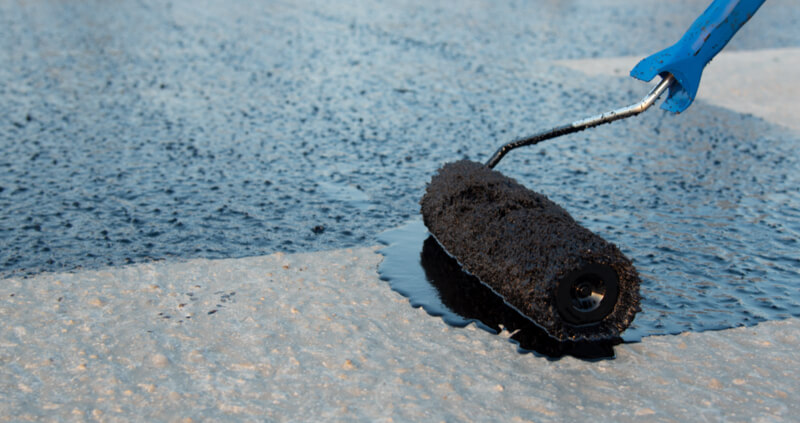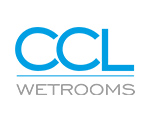
There are three main types of liquid waterproofing membranes – water or acrylic-based, polyurethane, and bituminous. A liquid waterproofing membrane is a versatile and effective solution for protecting a building or structure from water damage. The membrane prevents water from entering the building or structure so that it remains dry, and its service life is extended. That’s why it’s also an excellent choice for bathrooms and wetrooms.
Liquid waterproofing membranes must be flexible so they can expand and contract when a building or structure moves due to temperature changes, poor drainage, tree roots, and other factors. When this happens the structure of a wetroom or bathroom can also be affected which further highlights the need for a reliable liquid waterproofing membrane solution.
What is a liquid waterproofing membrane?
Liquid waterproofing membranes are a type of coating that is applied directly to the surface of a building or structure to create a waterproof barrier. They are commonly used in moist environments where high levels of water are present like bathrooms, wetrooms, and basements. These membranes work by forming a continuous and seamless layer over a surface which prevents water from penetrating into the underlying materials. Thanks to their high degree of elasticity, they can expand and contract when exposed to changes in temperature and humidity.
Liquid waterproofing membranes are typically made from a combination of resins, polymers, and other additives, which are mixed together and then applied using a variety of techniques including spraying, rolling, or brushing.
When should you use liquid waterproofing membrane?
There are several different types of liquid waterproofing membranes available that are designed for a variety of applications and conditions.
Applying a liquid waterproof membrane in the correct way creates a flexible barrier between a structure, the water and moisture. This process ensures the performance of the structure does not become weakened or compromised which will extend the longevity of your wetroom or bathroom.
It is essential to choose the correct type of liquid waterproof membrane for a specific project. There are several factors to consider when making your choice such as:
- Internal or external use
- Size of the area that requires covering
- Exposure to UV rays, dirt, and traffic
- Nature of the substrate such as soil, sand, gravel, or wood.
Applying a liquid waterproofing membrane in the correct way is also essential to the success of the project. The main reasons problems occur with liquid waterproofing membranes are poor preparation work and the wrong type of product for a specific task. When this happens membranes can come apart at the seams, allowing water to penetrate and damage a structure.
What are the three types of liquid waterproofing membranes?
Liquid waterproofing membranes can be placed into three main categories – water or acrylic-based, polyurethane, and bituminous. Each one is designed for use in specific conditions and for different applications from basement and foundation walls to kitchens, wetrooms, and bathrooms.
Choosing the correct liquid waterproofing membrane is essential for protecting a building or structure. Using the wrong type of liquid waterproofing membrane can lead to water ingress and damage to the building or structure to which it has been applied.
1. Water/acrylic-based membrane
Water/acrylic-based liquid waterproofing membranes are usually made from a combination of acrylic polymers and other additives, making them highly resistant to water and other environmental factors, such as UV radiation.
What is a water/acrylic-based membrane used for?
Water/acrylic-based waterproofing membranes are commonly used in applications where exposure to sunlight is a concern and can be applied to a variety of different surfaces due to their high flexibility.
Some common uses for water/acrylic-based liquid waterproofing membranes are roofing, balconies and decks, kitchens or wetrooms, bathrooms, and showers. They can withstand exposure to sunlight, rain, and other weather conditions, and can be applied to a variety of different surfaces, such as concrete, wood, or metal.
What are the pros of a water/acrylic-based membrane?
Due to their ease of application, versatility, and cost-effectiveness, water/acrylic waterproofing membranes are popular throughout the building and construction industry for many reasons including:
- Ease and speed of application as they can be sprayed, rolled, or brushed onto a surface.
- Quick drying time for shorter project durations and early access to the treated area.
- Strong adhesion to various substrates including concrete, metal, wood, and asphalt.
- Flexibility allows them to accommodate structural movement without compromising their waterproofing qualities.
- Cost-effective as they are generally more affordable than other liquid waterproofing membranes.
What are the cons of a water/acrylic-based membrane?
There are also downsides associated with water/acrylic-based membranes such as:
- Limitations when bridging larger cracks or gaps in the substrate.
- Despite their good durability, water/acrylic-based membranes may not be as resistant to heavy traffic as other options.
- Lower tolerance to water ponding when in prolonged contact with standing water causing premature degradation.
- Limited chemical resistance compared with other membranes such as polyurethane.
2. Polyurethane (PU) membrane
Polyurethane membranes are highly elastic and can withstand both positive and negative hydrostatic pressure. They are commonly used in roofing applications and can resist exposure to sunlight and other environmental challenges.
What is a polyurethane membrane used for?
Polyurethane membrane can conform to any shape or size of roof and is particularly effective in areas with complex geometries. They also offer an effective solution when keeping foundations watertight, can withstand the high pressure of water that can occur during flooding or heavy rain, and can be applied to both the interior and exterior of the foundation.
What are the pros of a polyurethane membrane?
The versatile nature and excellent properties of polyurethane membranes make them an effective waterproofing solution for the following reasons:
- Superior waterproofing performance due to the seamless, flexible, and durable barrier they create.
- High elasticity and flexibility for bridging gaps which won’t crack if a substrate moves.
- UV and chemical resistance during prolonged exposure to sunlight, particularly when used for exterior applications such as roofs and balconies.
- Long-lasting performance and lifespan due to their ability to withstand changes in weather, temperature, and environmental conditions.
What are the cons of a polyurethane membrane?
When using a polyurethane membrane there are some key factors which should be taken into consideration including:
- They are generally more expensive than water/acrylic and bituminous liquid waterproofing membranes.
- Applying polyurethane membranes requires a high level of skill to ensure correct installation and getting this wrong will affect waterproofing capabilities.
- Longer curing times compared to other options which could lengthen project times.
- Odour and toxicity associated with some polyurethane membranes which require adequate ventilation and safety measures.
3. Bituminous liquid waterproofing membrane
Bituminous membranes are made from a mixture of bitumen and other materials such as polyester or fibreglass. They are highly resistant to water and can be applied to a variety of different surfaces including concrete, metal or wood.
What is a bituminous membrane used for?
Bituminous liquid waterproofing membranes are often used in roofing applications including flat roofs and can be applied either hot or cold.
Additionally, bituminous membranes are used to waterproof the foundations of a building or structure. They prevent water from seeping in and can be applied to both horizontal and vertical surfaces. Bituminous membranes are also used in the construction of tunnels and in the lining of liquid retentive tanks.
What are the pros of a bituminous membrane?
There are many advantages to using bituminous membranes in building and construction work including wetroom and bathroom installations such as:
- Excellent waterproofing capabilities due to a continuous, impermeable barrier that prevents water penetration.
- Self-healing properties so small punctures or cracks self-seal over time.
- Strong thermal resistance so they withstand high temperatures without softening or melting.
- High versatility as they can be used for various applications including roofs, basements, and foundation walls.
- Durability and long-lasting qualities so they can withstand extreme weather conditions, UV exposure, and temperature fluctuations.
What are the cons of a bituminous membrane?
Before applying a bituminous membrane, the following aspects should be considered:
- Installation can be complex involving surface preparation, heating and melting the material, and applying in specific layers which requires specialist knowledge.
- Temperature sensitivity during installation which requires appropriate ambient and surface temperatures to achieve optimum adhesion.
- Strong odours omitted during installation mean appropriate ventilation is essential.
What is the best liquid waterproofing membrane for wetrooms, bathrooms, and showers?
Wet areas like wetrooms, bathrooms, or showers, can be a challenge for ensuring that everything from timber framing and flooring to insulation materials and electrical wiring are not exposed to water ingress.
Wetrooms, bathrooms, or showers experience higher levels of moisture, humidity and water and require a water/acrylic liquid waterproofing membrane for protection against water damage caused by leaks or spills. They can be applied to walls, floors, and other surfaces to create a durable barrier against moisture.
There are significant risks of water ingress with standard acrylic trays and wall showers and even higher risks with wetroom areas. Here, even small levels of moisture can damage flooring products resulting in swelling, widened joints, broken screws, and general deterioration of materials. Applying a water/acrylic liquid waterproofing membrane to the floor, walls, and tiled areas will provide strong protection against water damage so your wetroom, bathroom, or shower, can function properly.
When selecting a liquid waterproofing membrane for a wetroom, bathroom, or shower, it is important to choose a product that is specifically designed for wet areas and has been tested to meet relevant standards and regulations. It is also important to follow the manufacturer’s instructions to ensure the membrane is applied correctly. Alternatively, you could hire wetroom and bathroom experts to do the work for you.
What is Flexible Wall Membrane (FWM)?
Flexible Wall Membrane is an effective alternative to liquid waterproofing membrane and is used to waterproof a number of wetroom applications such as shower benches, corners, niches, and wall surfaces. This single-coat acrylic paste is designed for wetrooms, bathrooms and similar moist environments before ceramic tiles are applied. FWM can also be used to protect natural stone, porcelain, and other common wetroom materials from water damage.
FWM is simple to apply and is touch dry in just 30 minutes. Tiles can be applied in 24 hours and its versatile nature means it can be used on all common substrates such as plywood and OSB, offering a robust waterproof defence that won’t leak. FWM is commonly used for wetroom solutions in homes, apartments, leisure centres, swimming pools, hotels, and buildings of multiple occupancy.
Get Expert Advice on Liquid Waterproofing Membranes with CCL Wetrooms
With over 30 years’ experience in designing and manufacturing wetroom solutions, CCL Wetrooms is the UK’s leading wetroom expert. Contact us today.









